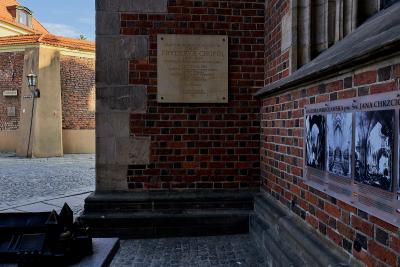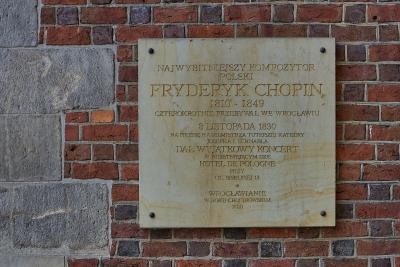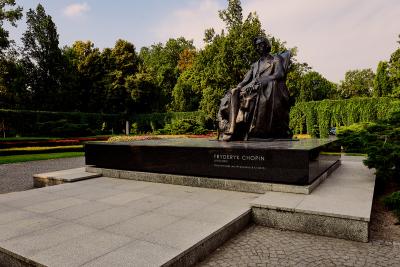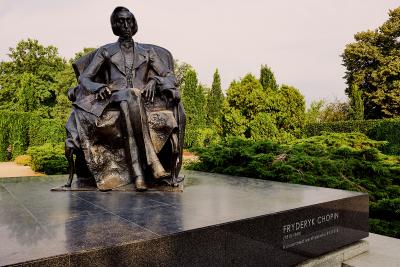“We were reluctant to leave Wrocław”. Frederic Chopin in the Silesian capital

The first links to Silesia
The young composer and pianist stayed in Silesia a number of times, sometimes only really experiencing Wrocław as he passed through, whilst on other occasions he enjoyed longer sojourns. Chopin made his first trip to this region, specifically to the Bad Reinerz health resort (now Duszniki Zdrój), with his mother and his sisters Ludwika und Emilia in July and August 1826. It was the home town of his teacher Joseph Elsner, who was born in Grottkau (now Grodków) in 1769 and attended the renowned St Matthias Grammar School before going on to study theology and then medicine in the city on the Oder.
The first few times Chopin stayed in Wrocław, on the way to Bad Reinerz and on the way back, he is said to have delivered letters which Elsner had written to his friends in Wrocław – Friedrich W. Berner, the organist at the Church of St. Elizabeth, and Joseph I. Schnabel, the director of music at the cathedral. Presumably, he also offered his services as a pianist on these occasions. Although he visited the houses of God, it is not known whether he also visited the city’s other sights at the time.
In summer 1829, Chopin, accompanied by his friends Alfons Brandt and Ignacy Maciejowski, arrived in Wrocław for the third time on his way back from Vienna. More precise details about this visit have not been passed down. What we do know, however, is that the young men stayed the night in the “Zum Rautenkranz” hotel in Ohlauerstrasse (now ulica Oławska).
In November 1830, Chopin was in the city again. This time it was a stopover on a journey from which, as it would later turn out, he would never return to his homeland again. He arrived at the “Zur Goldenen Gans” hotel in Junkerstrasse (now ulica Ofiar Oświęcimskich) with his friend and travel companion, Tytus Woyciechowski (1808–1879), a political activist and pioneering farmer. ;
“Zur Goldenen Gans”
There were a number of hotels in the city offering various standards. For Poles, the “Zur Goldenen Gans” hotel was right up their street because they could stay in clean rooms and enjoy delicious cooking. These, and other upmarket features, were something that this accommodation was renowned for, and it retained this reputation until the Second World War. The hotel was by no means cheap, as another famous Pole, Juliusz Słowacki, who stayed in Wrocław in March 1831, wrote in a letter to his mother on 12 April 1831:
“Naughty Wrocław – the people in the ‘Goldenen Gans’ really took me for a ride when I paid 30 Taler for 16 days, and for that I only had the pleasure of living in an ancient house whose roofs are higher than walls that are three floors high, whilst a cock crows and cats cry under the rooftops.” (Cited from Mikulski, ...)
The owner of the hotel was very enterprising and did everything he could to attract guests, even from the Russian partitioned territories [of Poland]. He put adverts in the Poznan and Warsaw papers in which he extolled the virtues of his establishment. He allegedly claimed that
„“(…) Polish and French are spoken in this hotel, and we subscribe to newspapers in these languages.”
During the Second World War. the hotel was destroyed and subsequently torn down.
“When we came to Wrocław from all corners of the globe in 1945, the ‘Zur Goldenen Gans’ hotel was still in the Ofiar Oświęcimskich-Straße – recalls Tadeusz Mikulski, a literary historian. There it stood – a huge square that had been gutted by fire during the siege of Wrocław. The way to the Goldenen Gans passed through a street strewn with bricks and stones and it took a certain amount of stamina to overcome these obstacles. We were quite emotional as we approached the ruins. On the wall, a large gilded bird with its wing broken off was still clinging on at the level of the second floor. It was the golden goose, the heraldic animal of the hotel.”
Impressions from this stay
During his last stay in Wrocław, Chopin and his friends had time to pursue the cultural offerings of the city and to meet with Elsner’s friends. On Saturday, 6 November, their very first day in the Lower Silesian metropolis, they visited the municipal theatre in Taschenstrasse (now on the corner of Oławska and Piotra Skargi streets) and watched the piece entitled “Der Alpenkönig und der Menschenfeind” by the Austrian dramatist Ferdinand Raimund, who was very popular in Warsaw. On Sunday, they met with the musical director at the cathedral, who Chopin already knew. Schnabel invited the composer to a rehearsal of the concert which was to take place the next day in the large ballroom at the “Hotel de Pologne” in Bischofsgasse (now ulica Biskupia). Chopin accepted this invitation. On the pretext of wanting him to try out the instrument, Schnabel talked Frederic into playing, and with this little ruse managed to rid himself of Hellwig, an amateur musician.
“Before Hellwig could sit down at the instrument – wrote Chopin on 9 November 1830 in a letter to his family from Wrocław –, Schnabel, who had not heard me play for four years, asked me to try out the piano. I could not refuse, so I sat down and played a few variations. Schnabel was absolutely delighted, Mr Hellwig lost his nerve, the others started to ask me if I would play in the evening.”
Chopin’s performance on the Monday was a complete success. There was no press release, however, as the event was only open to a small audience. And although the evening programme was to include the Romance from Chopin’s Concerto for Piano and Orchestra No. 1 in E minor (Op. 11), he only played the Rondo. In the letter mentioned above, the musician wrote about the concert and the reception that followed:
“As well as the Rondo, I improvised a theme from ‘The mute girl of Portici’ for the connoisseurs. At the end, an overture was played and afterwards there was dancing. (…) A lady – continued Chopin –, who the director introduced me to after the concert as the first local pianist, thanked me very much for the pleasant surprise and expressed regret that I do not play in public.”
No further details have been passed down about the places that Chopin and his friend visited over the next few days. Presumably, Scharff, a businessman that they had got to know by chance, showed them around:
“He led us (...) through the whole of Wrocław, even hired a hackney carriage, and drove round with us on the most glorious promenades.”
The composer was obviously very impressed by the city. When he left Wrocław on 10 November 1830, he was unable to hide his sorrow.
“We were reluctant to leave Wrocław”, wrote Chopin from Dresden.
But Paris, the capital of the world, was waiting for him. Twenty days later, the November Uprising broke out in Warsaw.
Krzysztof Ruchniewicz, June 2018
The citations are taken from:
Tadeusz Mikulski, Pod Złotą Gęsią, [in:] ders., Spotkania wrocławskie, Kraków 1954, page 121. Polskie podróże po Śląsku w XVIII i XIX wieku (bis 1863), selected and edited by Andrzej Zieliński, Wrocław 1974, pages 161-163.
From Chopin’s letters cited from: The collected letters of Frederic Chopin. Published for the first time and translated faithfully into German by Bernard Scharlitt, Leipzig 1911, pages 105-107.










